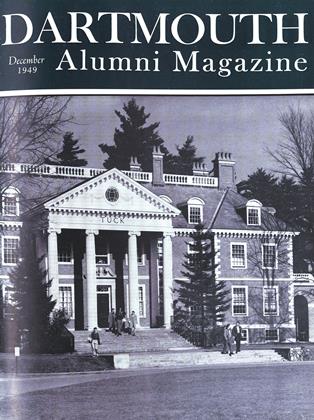by Charles O'Neill '31.Simon and Schuster, 1949, 392 pp., $2.95.
For the second time in a year, the hero of a top-flight book is a Dartmouth man. As with Charles Gray in "Point of No Return," however, O'Neill's figure of Theron Hawley has only a fictional connection with Hanover. But the scenes through which he is moved are, thanks to a brow-furrowing amount of research, based on documentable fact. So, too, are many of the principal characters—George Rogers Clark, John Langdon, James Madison and others. Parenthetically, a number of the minor characters have been assigned names that will be amusingly familiar to those who were in college during the early 30's.
The story turns on the experiences of Hawley following six years' service in the Revolutionary War. As he makes his way home through Vermont, he has no larger thoughts than to find a wife and settle down. But events steer him west via Philadelphia to Kentucky where he becomes involved with Gen. James Wilkinson, the obscure figure of American history who, it is known from archives in Madrid, drew secret pay from Spain for seventeen years while still commanding troops under the Stars and Stripes. Hawley discovers his treachery which probably would have made the South a Spanishspeaking domain today and, in a series of heart-racing adventures that carry him up the Natchez Trace to Mount Vernon and beyond, spoils the play.
In so doing, he influences the momentous decision then in balance as to whether the loose confederation of thirteen separate sovereignties shall be tightened into the truly United States known today. O'Neill never mentions it but he makes a clear analogy between the 1780's when Americans from Vermont to Kentucky had to be weaned from notions of a separate government for each state and today when, on an international rather than national level, men everywhere with the possible exception of the Chinese who have already proposed it must give over some measure of nationalism in favor of a world federalism.
It will be interesting to see whether Hollywood can be tempted by "Morning Time." There's color and drama and, if it counts, social significance enough for two or three shows. But there may be some balking in the studios at the high point of the love interest which occurs as Hawley finally has his way with the winsome Irish heroine in—of all unlikely and probably unfilmable places—the interior of a semi-submerged beaver hutch.
 View Full Issue
View Full Issue
More From This Issue
-
 Article
ArticleOUR GREATEST ISSUE
December 1949 By BRUCE W. KNIGHT -
 Article
ArticleNew Development Council Formed
December 1949 -
 Class Notes
Class Notes1923
December 1949 By TRUMAN T. METZEL, COLIN C. STEWART, JULIUS A. RIPPEL -
 Class Notes
Class Notes1918
December 1949 By ERNEST H. EARLEY, DONALD L. BARR, DAVID L. GARRATT -
 Class Notes
Class Notes1943
December 1949 By ELMER G. STEVENS JR., STANTON E. PRIDDY -
 Article
ArticleIt's An Old Spanish Custom of Speech
December 1949 By CHARLES L. YOUMANS '20
Books
-
 Books
BooksTHE PROBLEMS OF ADMISSION TO COLLEGE
June 1929 -
 Books
BooksVERMONT: A SPECIAL WORLD.
OCTOBER 1969 By C. E. W. -
 Books
BooksWHITE HUNTER, BLACK HEART.
April 1954 By CLIFFORD L. JORDAN '45 -
 Books
BooksPATRIOTISM AND NATIONALISM — THEIR PSYCHOLOGICAL FOUNDATIONS.
APRIL 1965 By LLOYD H. STRICKLAND -
 Books
BooksAMERICAN WRITING MASTERS AND COPYBOOKS:
APRIL 1959 By SINCLAIR H. HITCHINGS '54 -
 Books
BooksNEW WORLD OF MACHINES
May 1945 By Virgil Poling

